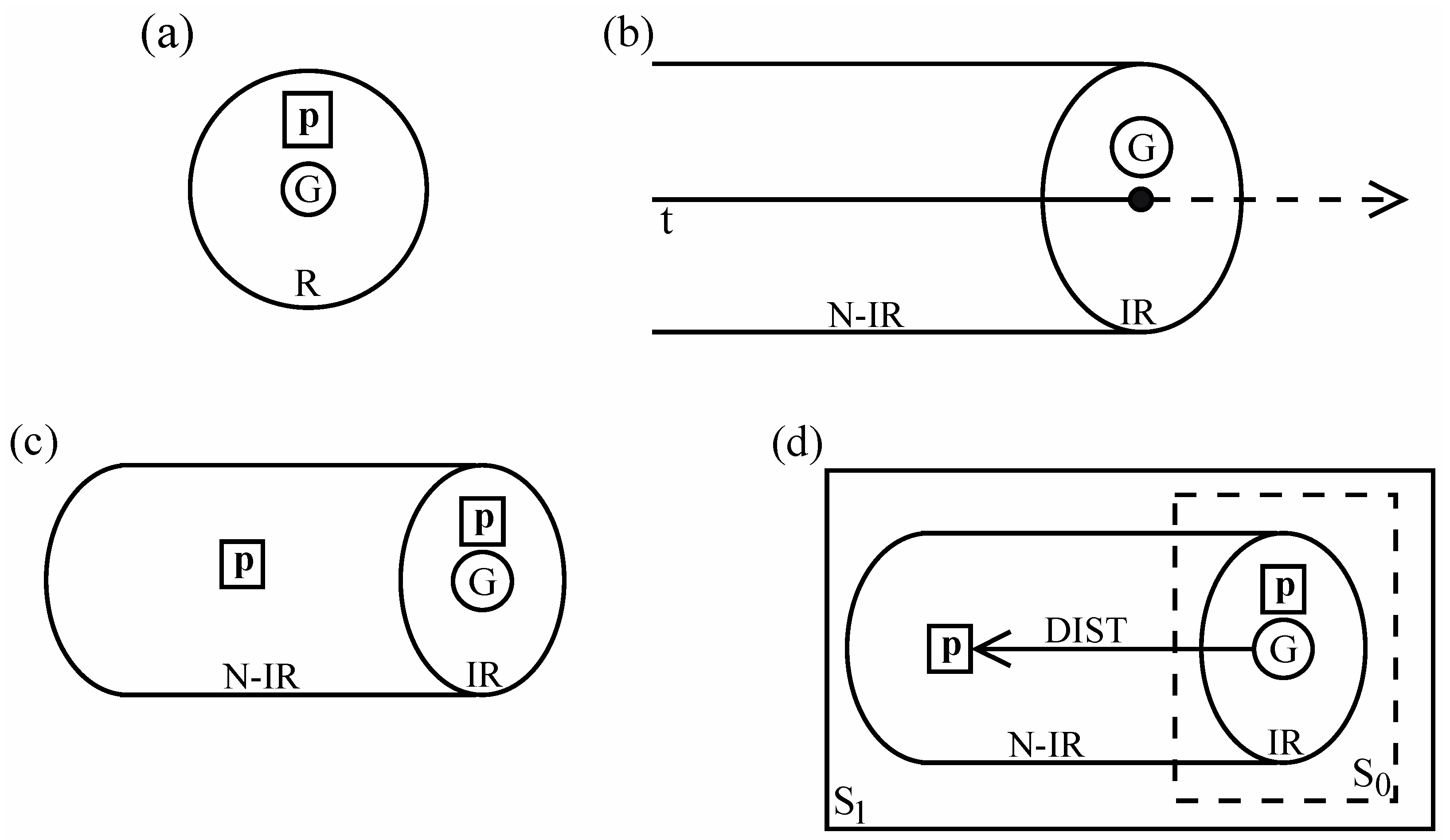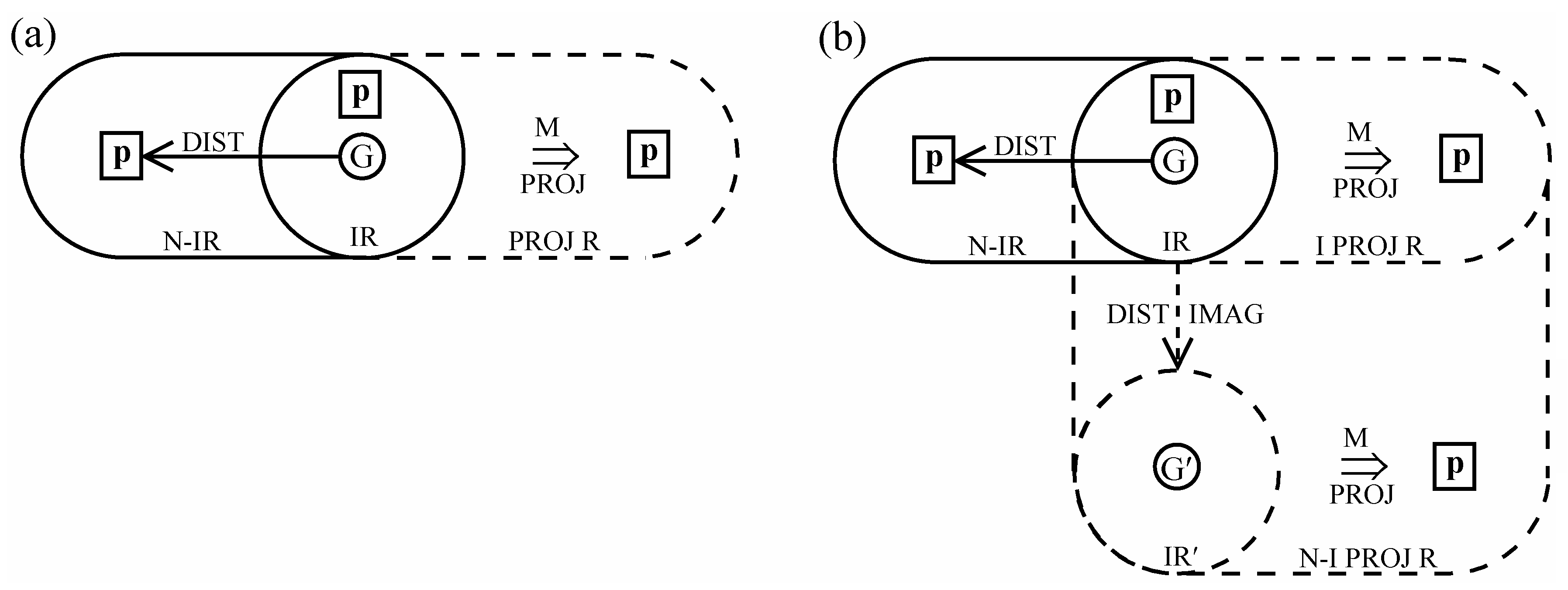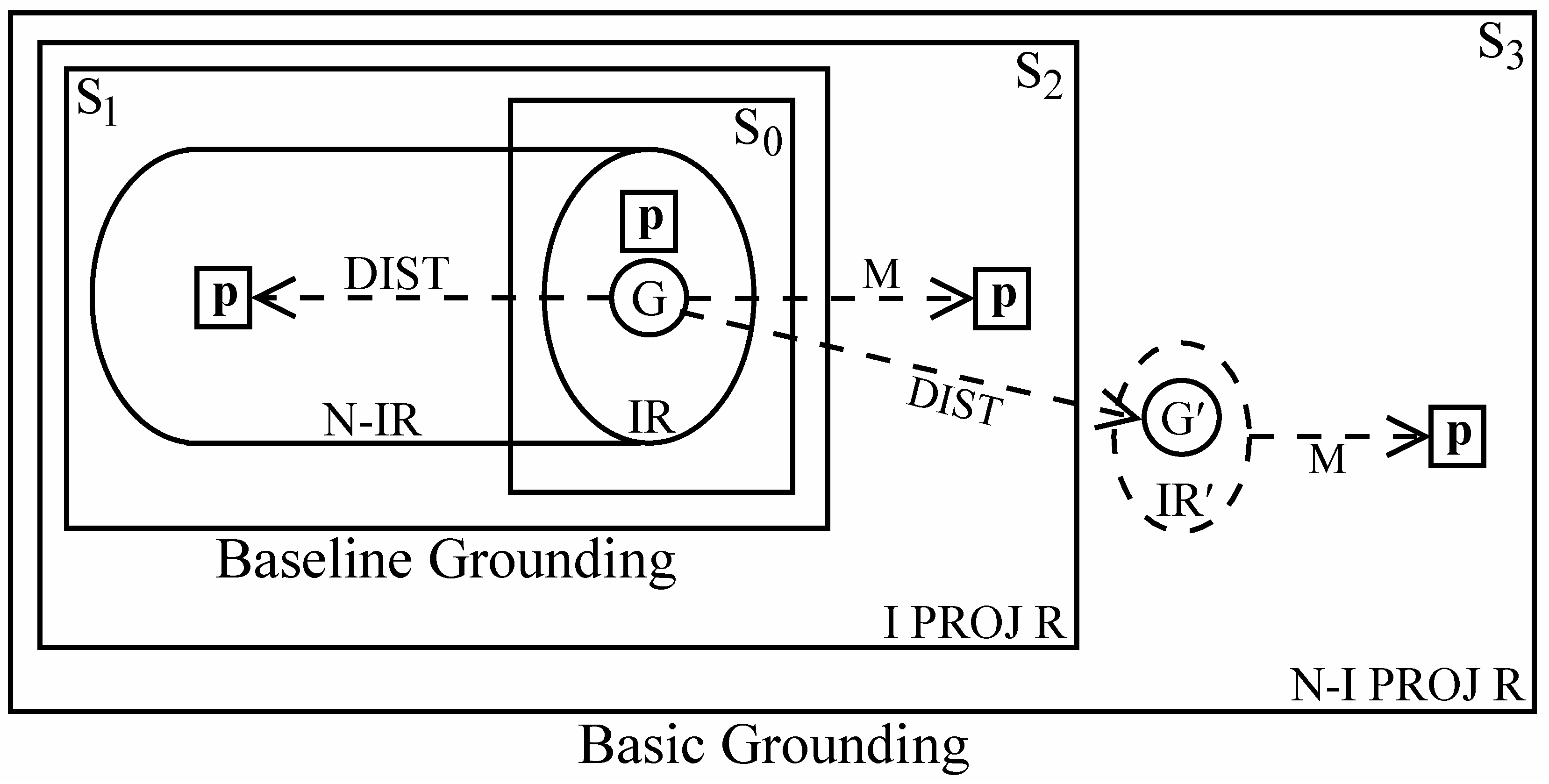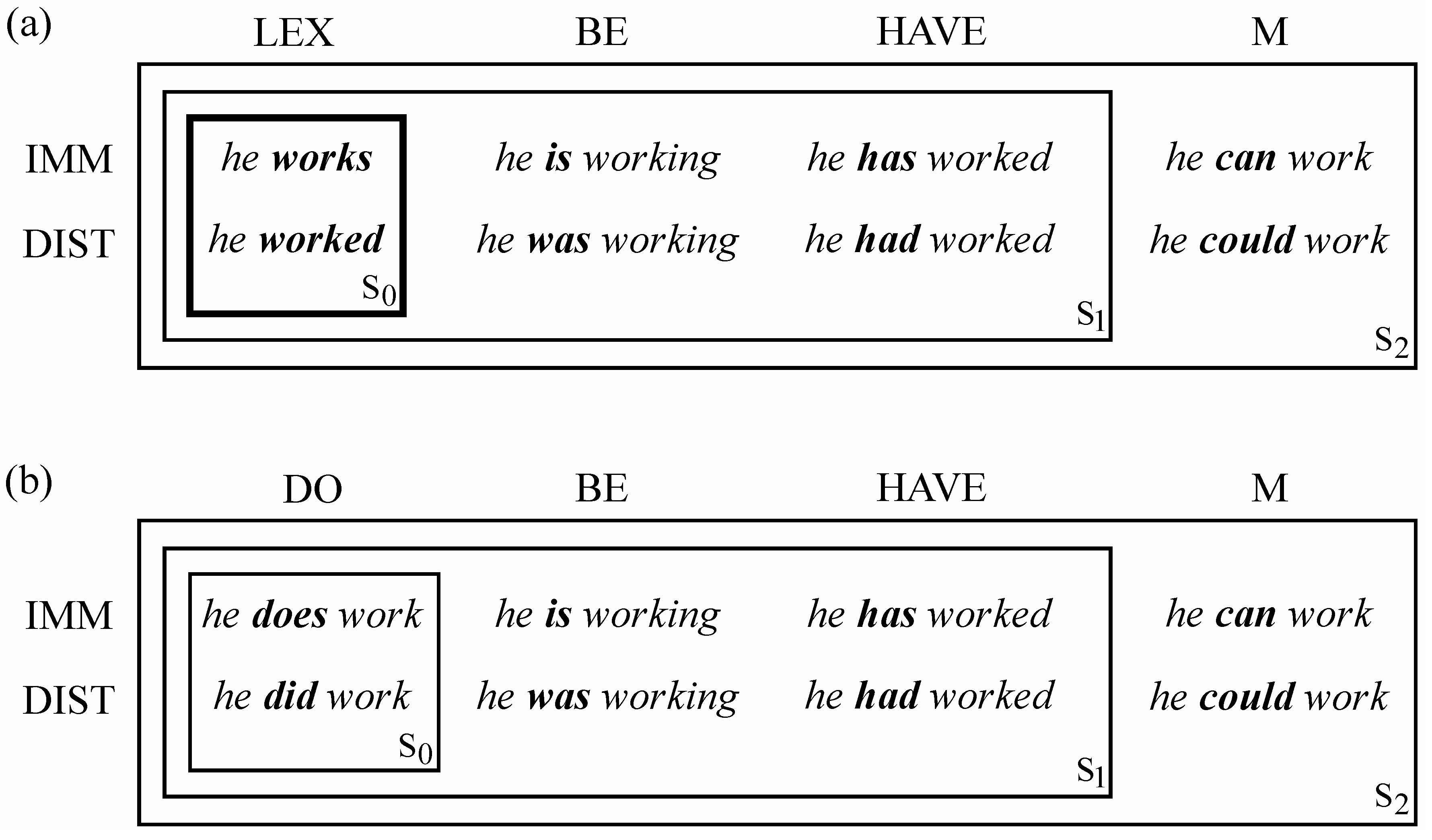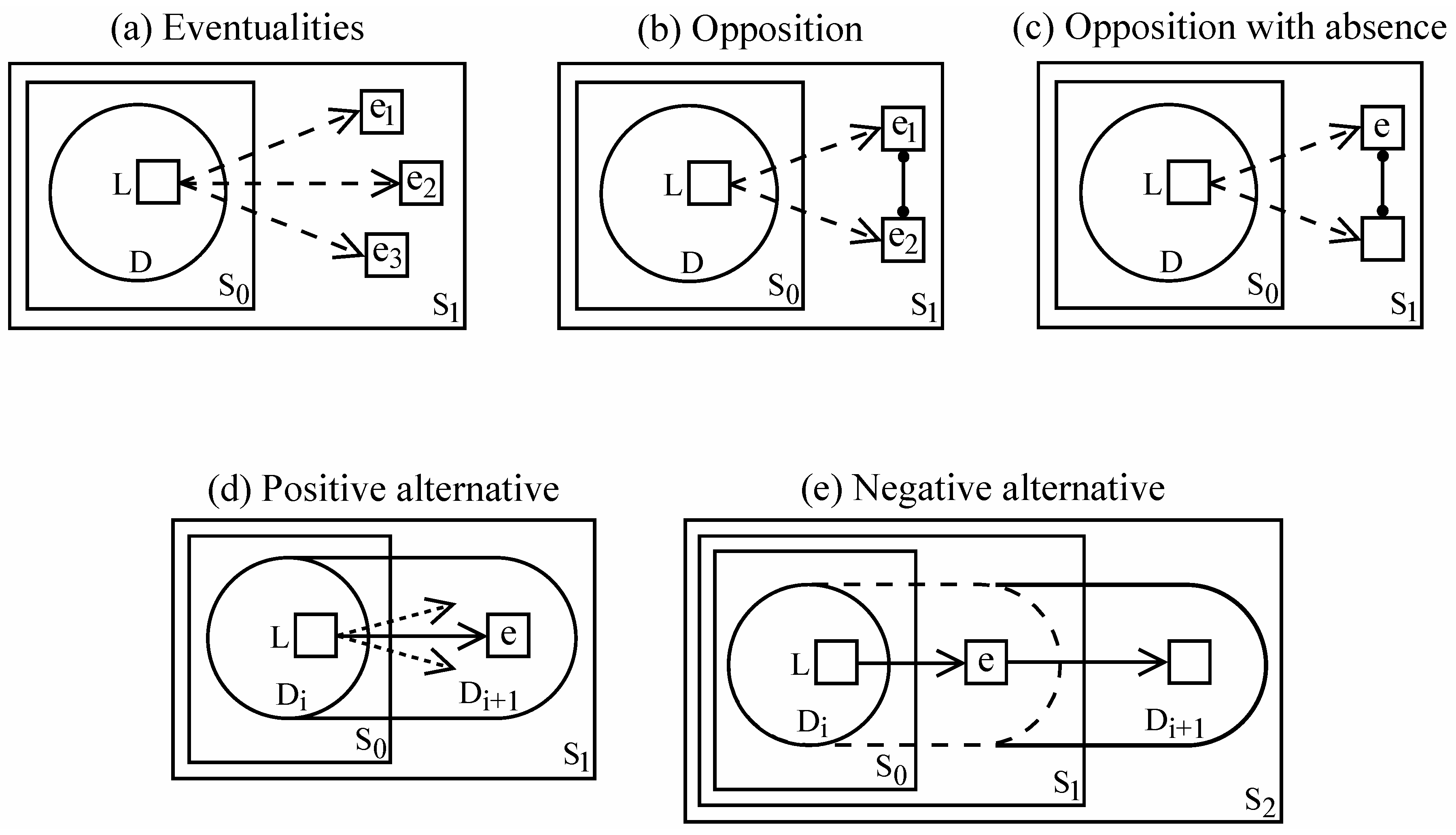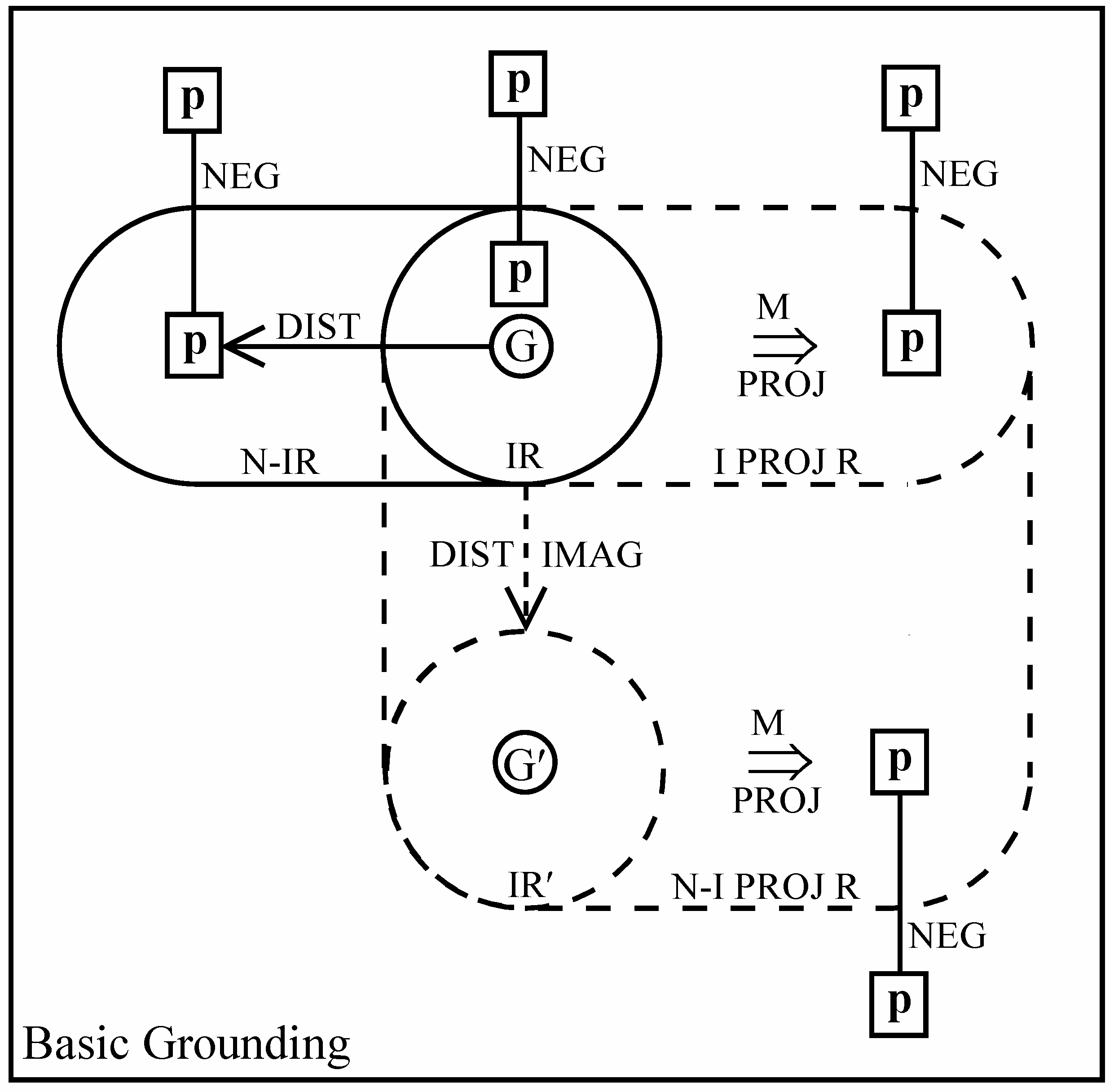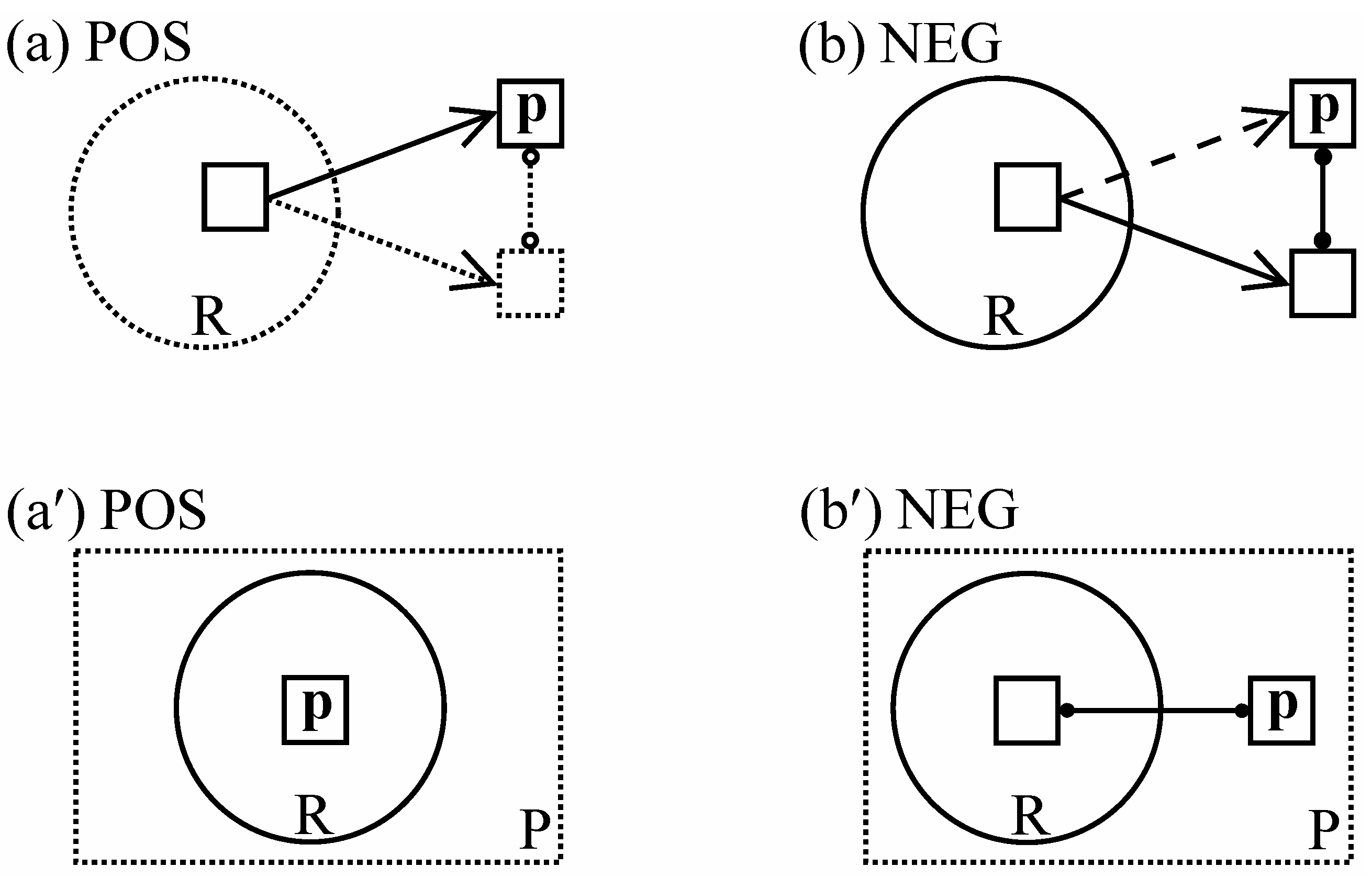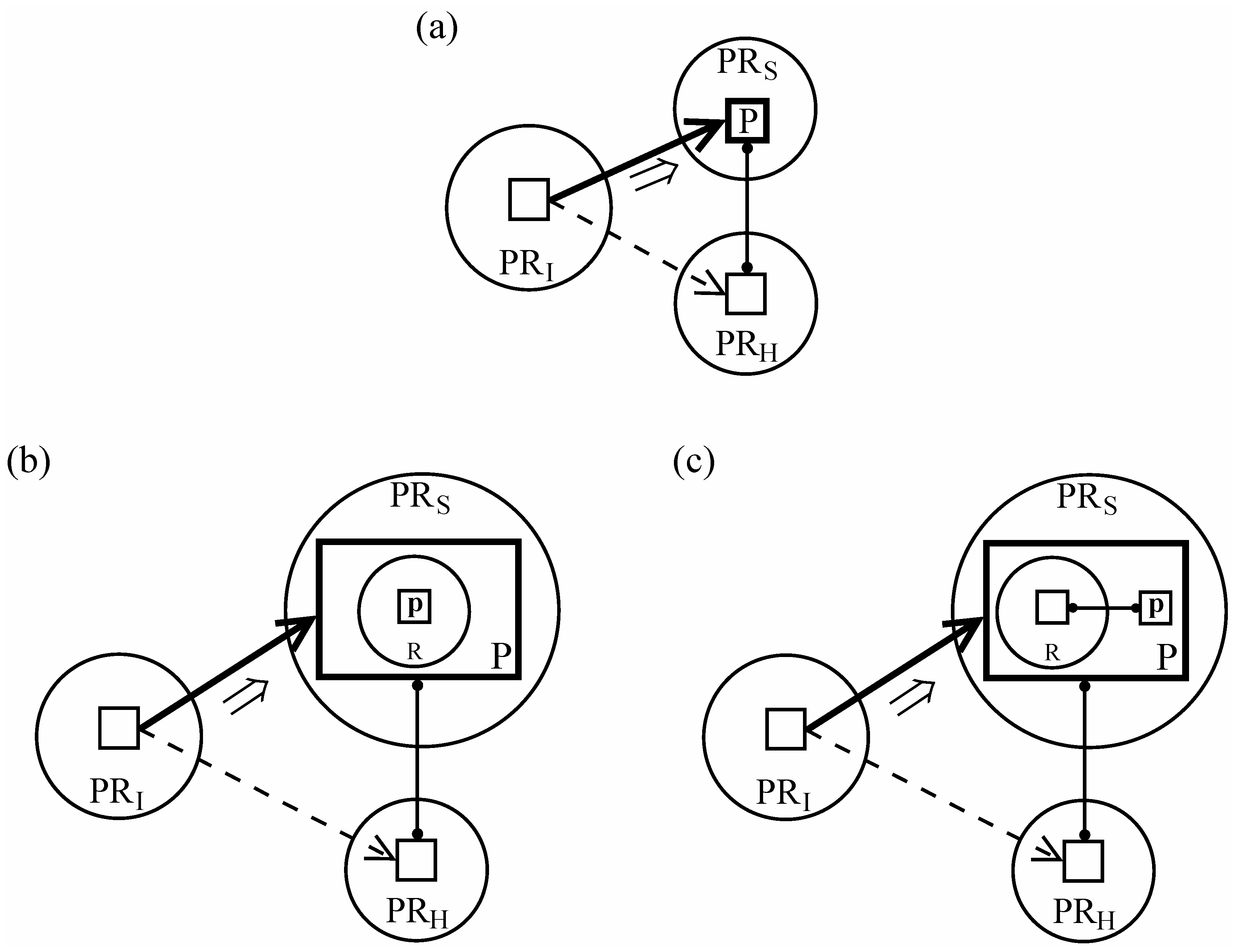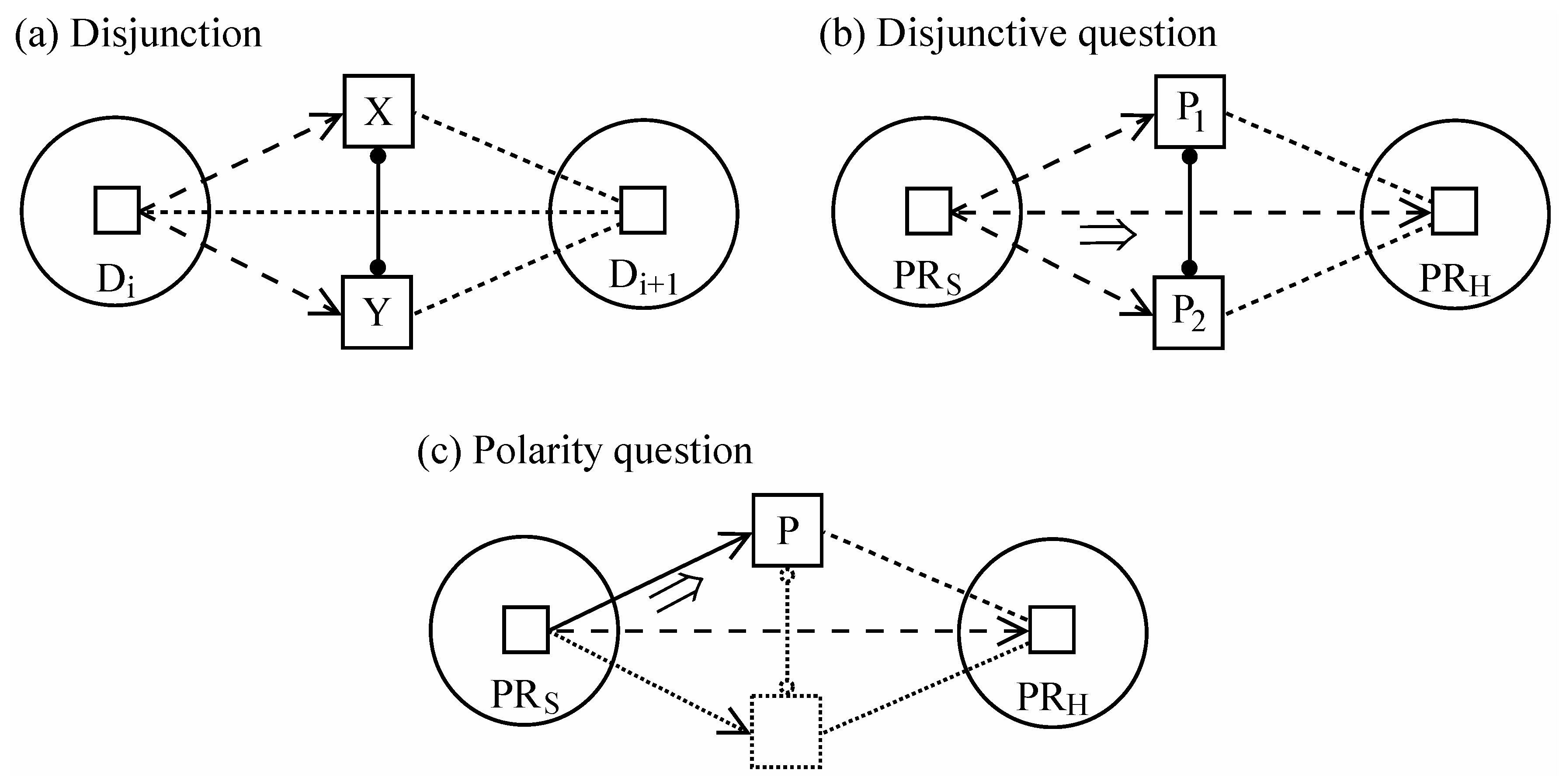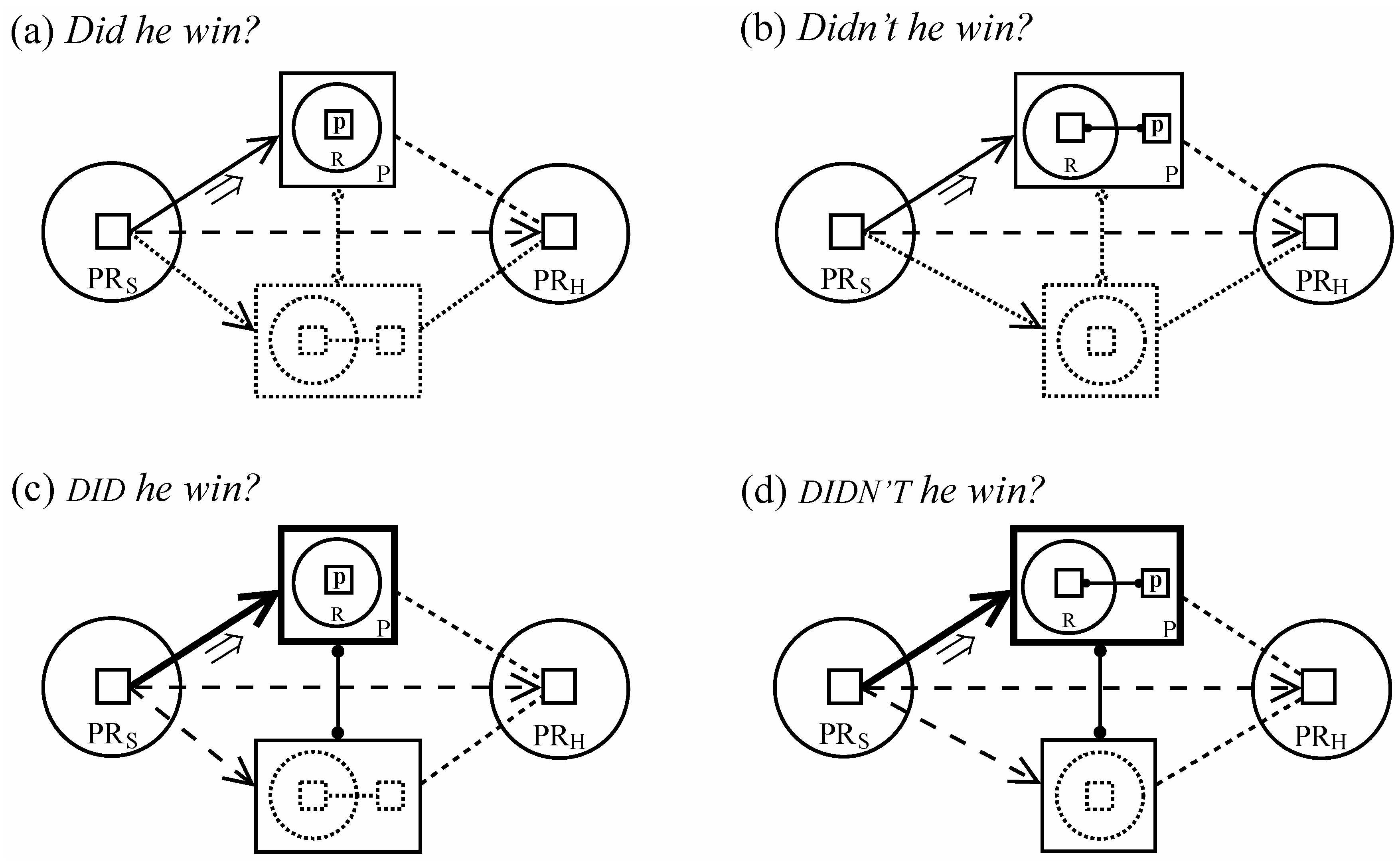1. Introduction
I will be examining two fundamental aspects of conceptual and linguistic structure in relation to one another: a general feature of cognition I refer to as
B/E organization (
Langacker 2016); and a cognitive model representing our conception of
reality. Together they allow a cogent description of central features of English clause structure.
Linguistic structure tends to be organized in successive levels (or strata), each a baseline (B) giving rise to the next by elaboration (E). The higher stratum incorporates additional resources affording a wider array of structural options. For instance, from a baseline vowel system [i e a o u], representing one stratum (S0), the added resource of nasalization yields the elaborated system [[i e a o u] ĩ ẽ ã õ ũ] at a higher stratum (S1). A noun and its corresponding plural belong to different strata: conceptually and formally, dogs elaborates the baseline expression dog. The conception of one represents the default and the point of departure for conceiving of more than one.
What I mean by reality is not based on physics or philosophy, but on human experience as reflected in language structure. It is not limited to what we call the “real world,” nor to physical or observable entities. For example, all of the following count as being “real” for present linguistic purposes: fictive worlds (Santa Claus is fat); abstract entities (pi is an irrational number); social and cultural notions (religious freedom is guaranteed by the constitution); products of metaphor and blending (we’re drowning in red ink); generalizations (a tiger has stripes).
I suggest that relevant aspects of English clause structure are revealingly described in terms of a cognitive model reflecting fundamental aspects of pre-linguistic experience (
Langacker 2013, p. 15): “According to the
reality model, affairs in our world have unfolded in a particular way, out of all the ways conceivable. There has been a certain course of events, whereby certain events and situations have occurred, while countless others have not.
Reality (R) is the history of occurrences, up through the present moment. This history cannot be changed; what has happened has happened. Reality is thus the
established course of events. Future events are excluded from reality (so defined) because they have not yet occurred and thus have not been either established or fully determined. Moreover, our knowledge of reality is only partial and imperfect. Each of us has our own “take” on it, our own
reality conception (RC). For a given conceptualizer (C), RC comprises what C accepts as
real—i.e., as having occurred, or having been
realized. This conception is always incomplete, and C is bound to be mistaken in many respects. But rightly or wrongly, RC is what C
knows.”
Specific linguistic properties motivate the assignment of clauses to three main strata involving different levels of reality: baseline clauses and reality (e.g., Alice resembles her mother, Sam broke a cup); basic clauses and reality (she may have been followed, he didn’t graduate on time); interactive clauses and propositional reality (he did graduate, have they left?). These will be considered in turn.
2. Baseline Level
The description is based on Cognitive Grammar (
Langacker 2008), which holds that grammar is inherently meaningful, residing in assemblies of
symbolic structures (form-meaning pairings). For basic universal categories, like noun and verb, the framework posits both a schematic meaning, valid for all members, and a prototype corresponding to central members (
Langacker 2015a). The prototypes are experientially grounded
conceptual archetypes:
objects in the case of nouns, and
events for verbs. The schemas reside in
basic cognitive abilities inherent in the conception of objects and events: for nouns, the grouping of entities into one; for verbs, tracking a relationship through time. Conceptual archetypes—notions like object, event, substance, force, time, space, location—serve as a
baseline for cognitive and linguistic development. The conceptual motivation of grammatical structure is thus most evident at this level.
2.1. Existence
We say that objects exist, whereas events occur, but I view these as manifestations of the same abstract notion: just as objects reside in the spatial existence of substance, events reside in the temporal existence of relationships. Also existing in space, and coded by nouns, are entities such as people, substances, and features of the spatial surroundings. Existing through time, and coded by verbs, are not only events but also states—stable relationships conceived as extending through time without inherent limit.
Just for the sake of discussion, we can identify baseline reality with entities that exist in space and time. What counts here as reality (R) is conceived reality as reflected in language. R is a structure: an immense assembly of entities connected via relationships. This structure is dynamic, continually evolving through time; notably, it “grows” as the passage of time brings new events. These events unfold within a relatively stable framework comprising those facets of R which endure through time. This includes both states and objects (for which endurance is the default expectation). An object’s persistence through time is itself a kind of state. Thus reality, characterized above as the established history of occurrences, can also be described as the totality of what has existed.
Objects are coded by nouns, events and states by verbs. An expression’s category depends on its profile: the entity it designates (or refers to), hence the focus of attention within the conceptual content invoked. A noun refers to a thing, prototypically an object (it is characterized schematically as a grouping conceived as a single entity). Its profile is the object per se, whose existence through time is merely presupposed. With verbs, on the other hand, evolution through time is an essential feature. A verb profiles an occurrence (or process), i.e., a relationship followed through time. Occurrences include both events and states. It is important in what follows that the existence of a relationship—its evolution through time—represents the schematic meaning of a verb.
2.2. Substrate and Structure
An expression’s meaning is never self-contained. It emerges from an elaborate conceptual substrate, including background knowledge, the object of discussion, the speech situation, and the ongoing discourse. We can recognize different strata (levels of organization) based on the complexity of expressions and the conceptual resources they demand. The initial stratum corresponds to baseline clauses, such as Alice resembles her mother or Sam broke a cup. Their structure reflects an implicit scenario for language use in its simplest, most canonical form.
In this scenario, there are two interlocutors, a speaker (S) and a hearer (H). The interlocutors and their immediate circumstances constitute the ground (G). In the baseline viewing arrangement, S and H are together in a fixed location, from which they observe and describe actual occurrences in the world around them. Their interaction consists of baseline speech acts: statements presumed to be valid. A baseline usage event is one such instance of language use; the expression produced is a single baseline clause, which describes some aspect of baseline reality.
A baseline clause has just a few essential elements: a verb, which profiles an occurrence; one or more nominals, describing its participants; and tense to indicate location in R. It is minimal because the substrate incorporates default values for numerous features. Among the things absent are modals, negation, indications of speech act, multiclause expressions, and connected discourse. Departures from the baseline, being conceptually more complex, come about through structural elaboration at higher strata.
A full clause represents the structural implementation of two basic semantic functions: description of the profiled occurrence; and grounding (how it relates to the ground). Description starts with a lexical verb (like see, resemble, run, or break), which specifies a basic type of occurrence—one schematic regarding its participants. Their specification by nominals produces an elaborated type, such as Alice resemble her mother or Sam break a cup. Grounding by tense then yields a clause: Alice resembles her mother; Sam broke a cup. Due to grounding, the profiled occurrence is conceived as an instance of the higher-order type, distinguished from other instances by its temporal location.
Grounding pertains to the epistemic status of the profiled thing or occurrence: how it relates to what the interlocutors purport to know. For nominals, the main epistemic concern is identification of the referent. For clauses, the main concern is existence, or the referent’s status vis-à-vis reality. Since the baseline scenario specifies that the interlocutors observe and describe actual occurrences in the world around them, their reality is presupposed.
So as shown in
Figure 1a, the baseline scenario locates
p, the profiled occurrence, in reality (where G is also found). In
Figure 1b, R is depicted as a cylinder that “grows” through time (t). The “face” of this cylinder, representing R’s manifestation at the current moment, is referred to as
immediate reality (IR). The remainder of R is
non-immediate reality (N-IR). Thus
p can either be immediate to G (in IR) or non-immediate (in N-IR), as in
Figure 1c. Since reality is taken for granted at this stratum, and the time of speaking is a facet of G, immediacy vs. non-immediacy to G translates into
present vs.
past in time—the prototypical value of the so-called “tense” markers (
resembles vs.
broke). This correlates with the experiential factor of whether the occurrence can be observed directly or only via memory. Accordingly, the arrow in
Figure 1d indicates that prior occurrences lie at a certain
distance (DIST) from G both temporally and experientially. And memory being an additional conceptual resource, they also represent a higher stratum. Thus grounding at the baseline level (a main stratum) can itself be differentiated into substrata, with S
1 representing an elaboration vis-à-vis S
0.
3. Basic Level
Basic clauses elaborate the baseline in regard to both description and grounding: for description, by means of perspectival adjustments; and for grounding, in the form of grammaticized modals.
3.1. Perspective
The perspectival adjustments are effected by passive, progressive, and perfect constructions. The passive affects the choice of subject by conferring that status on the participant that would otherwise be the object: expect > be expected. The progressive restricts the profiled occurrence to an internal portion of the occurrence profiled by the verb: cry > be crying. The perfect describes a state in which the verbal occurrence is apprehended from a reference point later in time: finish > have finished. Each construction is complex, involving two levels of composition. At the first level, a verb is elaborated morphologically to derive a participle: a so-called “present participle” (crying) or a “past participle” (expected, finished). Though derived from a verb, a participle does not itself function as such; grammatically it is more like an adjective (cf. crying baby, expected outcome). At the higher level, the participle combines with a schematic verb, be or have. They function as heads in these constructions by imposing their verbal nature on the content supplied by the participle. The result in each case is a complex verb describing an occurrence apprehended from a certain perspective, as determined by the participial element.
Reflecting their common perspectival function, these constructions are parallel in formation and mutually exclusive, in that only one can be used with a given verb; they constitute a system of opposing elements. When they co-occur, it is only because the “output” of one construction—being a complex verb—can itself participate in another. The conventionally established combinations are listed in (1). Each construction elaborates a verbal expression to form a more complex verbal expression at a higher level of organization. The lower-level expression is either the lexical verb (like
watch) or a complex verb resulting from prior elaboration (e.g.,
be watched). The higher-level expression comprises
be or
have followed by a simple or complex participle (e.g.,
watching,
being watched) that incorporates perspective.
| 1. | a. | PASSIVE > PROGRESSIVE: | watch > be watched > be being watched |
| | b. | PASSIVE > PERFECT: | watch > be watched > have been watched |
| | c. | PROGRESSIVE > PERFECT: | watch > be watching > have been watching |
| | d. | PASSIVE > PROGRESSIVE > PERFECT: | watch > be watched > be being watched |
| | | | > have been being watched |
As
schematic verbs,
be and
have profile the
existence of a relationship—its evolution through time—but do nothing to specify its nature. They serve to convert the participial expression into a complex, higher-order verb in which the relationship followed through time is the one coded by the participle. The profiled occurrence is thus distinct from that of the lexical verb. For example,
watch and
be watching have the same descriptive content but profile different occurrences: the full event vs. an internal portion of it. At each stratum, one verb functions as
head in the sense that the occurrence it profiles is profiled by the full verbal expression. In (1), boldface indicates the head at each level: the lexical verb,
be, or
have. The occurrence profiled by the highest-level head is the one whose epistemic status is specified by grounding—the one labeled
p in
Figure 1. The highest-level head is thus the
grounded verb, and the full verbal expression represents the
grounded structure. In baseline clauses, the grounded verb is just the lexical verb:
She watched him. But in basic clauses with perspectival adjustments, these functions are differentiated:
She had been watching him.
Not every basic clause has a lexical verb. A frequent alternative is the combination of be with an adjective or a prepositional phrase: The cat is {ugly / on the mat}. Adjectives and prepositions profile relationships, but they are not verbs because they do not focus on its evolution through time; the situation they describe is fully manifested at a single instant (and can thus be observed in a photograph). Their combination with be reflects the conceptual characterization of a verb: that it profiles a relationship followed through time. It differs from a lexical verb only in that the relationship and its tracking through time are expressed by separate elements. It can also be recognized as a variant of the perspectival constructions. The difference is that it creates the functional equivalent of a lexical verb, whereas a perspectival construction starts with such a verb.
3.2. Modality
Perspectival constructions represent one dimension of elaboration leading from baseline clauses to basic clauses. Another dimension is the elaboration of grounding to include modality. This introduces a higher level of reality.
At issue are the grammaticized modals may, will, can, shall, must, might, would, could, and should. These function as grounding elements, occurring in lieu of tense (e.g., likes/liked vs. will like/would like). The modals exhibit B/E organization. In terms of both form and meaning, the basic forms may, will, can, and shall constitute the baseline, being elaborated by the distal forms might, would, could, and should. We will not be concerned with their many idiosyncrasies, focusing instead on what they have in common.
I follow
Talmy (
1988) and
Sweetser (
1990) in viewing modals as
force-dynamic in nature (
Langacker 2013). With an
effective (or “root”) modal use, the force (⟹) has a potential
effect on the evolution of reality. It is often a matter of permission, obligation, or ability. Here we will consider only
epistemic modal uses, which pertain to speaker
knowledge. The force is internal to the conceptualizer (C): the
mental effort involved in
projecting the growth of R along a path that results in
p’s incorporation. It reflects C’s assessment of the likelihood of
p being
realized. This ranges from mere potential (
he may be angry) to virtual certainty (
he must be angry).
The basic modals (M) elaborate the baseline grounding system as shown in
Figure 2a. They afford a wider range of options, allowing both
real occurrences and those whose realization can be
projected (with varying degrees of confidence). In contrast to baseline grounding, where
p is limited to R, a modal specifically removes it from R. Reality is still at issue since the modal projection envisages
p as part of an
updated reality conception. We can therefore recognize a higher, more inclusive level of reality that encompasses not only baseline reality (R) but also
projected reality (PROJ R). At this higher stratum reality comprises both the
established course of events and the
projected course of events.
In a finer-grained description, represented in
Figure 2b, projected reality can be differentiated into substrata in just the same way that baseline reality is. The notion of distance (DIST) divides projected reality (PROJ R) into
immediate projected reality (I PROJ R) and
non-immediate projected reality (N-I PROJ R). This distinction reflects the semantic contrast between the basic modals
may,
will,
can, and
shall and their elaborated (distal) forms
might,
would,
could, and
should. Despite their semantic idiosyncrasies, the latter consistently specify a greater epistemic distance from G—a longer
epistemic path—than their basic counterparts. Note the examples in (2):
would and
could contrast with
will and
can by being counterfactual;
might contrasts with
may by indicating a more tenuous possibility; and while
shall represents a command,
should just describes an obligation.
| 2. | a. | I will if I can vs. I would if I could. |
| | b. | He may be home—the lights are on. vs. He might be home, but the lights aren’t on. |
| | c. | You shall do that. vs. You should do that. |
The distal modals invoke an additional conceptual resource:
imagination (IMAG). The modal projection is not made from the actual ground (G) in immediate reality (IR). Rather, the speaker imagines a somewhat different situation, G′ (as part of IR′), from which the projection indicated by the basic modal form would be appropriate. There is thus a longer epistemic path from G to
p. As seen in (3a), a basic modal locates
p in a single step; starting from
immediate reality (IR), where he is not poor,
will directly places
p in
immediate projected reality (I PROJ R). By contrast, a distal modal proceeds indirectly by first invoking an imagined situation, IR′, distinct from IR in some respect. In (3b), the actual situation (in IR) is that he is poor. From there, the path to
p proceeds in two steps reflecting the status of
would as the distal form of
will. First, imaginative distancing (--->) induces the fictive conception (IR′) of his not being poor. And from that situation, the modal projection of
will leads to
p, placing it in
non-immediate projected reality (N-I PROJ R).
| 3. | a. | Since he is not poor, she will marry him. |
| | | | [he is not poor (G/IR)] ⇒ [she marry him (I PROJ R)] |
| | b. | If he were not poor, she would marry him. |
| | | | [he is poor (G/IR)] ---> [he is not poor (G’/IR′)] ⇒ [she marry him (N-I PROJ R)] |
3.3. Finite Verb
Figure 3 summarizes the grounding options discussed so far.
p is the profiled occurrence whose epistemic status is specified by tense and modality. We can take this to be the grounded structure as a whole, or more specifically its head, the verb which imposes its profile on that structure. Dashed arrows represent the epistemic path leading from G to
p, each step residing in either distancing (DIST) or projection by a basic modal (M). Strata are labeled based on the length and nature of the path: at S
0, immediacy to G amounts to a path of zero length; S
1 and S
2 involve alternate one-step paths; and in S
3 we have the two-step path of a distal modal. The options in S
1 constitute the
baseline grounding system, and those in S
3, the
basic grounding system.
In baseline clauses, the lexical verb functions as head (
p). It is therefore the
grounded verb, the one on which epistemic status (immediacy) is registered (
she watched him). In basic clauses, the functions of lexical verb and grounded verb are
differentiated (
she had been watching him), since the highest-level head is a schematic verb:
have,
be, or
do. A key to the verbal organization of English clauses is a further, subtle distinction between the grounded verb and what is traditionally called the
finite verb (
Langacker 2015c). The finite verb is the one marked for “tense.” More specifically, it is the
verb word which registers
immediacy—whether the profiled occurrence is immediate or non-immediate to the ground. (Why a word? Because word order plays a role in grounding at higher strata.) When there is no modal, the finite verb is the tense-marked form of the grounded verb, e.g.,
had in the clause
he had finished. In this case
have is the grounded verb by virtue of being the highest-level head in the grounded structure (
he have finished). Grounding is marked on this verb, resulting in
had, which is the finite verb because it is a word specifying the non-immediacy of the occurrence it profiles.
A modal changes this picture because it qualifies simultaneously as a word, a grounding element, and a head. Forms like may, will, could, and should are clearly words. They belong to the grounding system because their function is not to describe an occurrence but to indicate its epistemic status. And they qualify as heads because they profile an occurrence that is also profiled by the clause as a whole.
As characterized in Cognitive Grammar, highly grammaticized grounding elements profile the grounded entity, rather than the ground or the grounding relation (
Langacker 2002). The conceptual structure of a modal is thus as follows, where
p is a fully schematic occurrence related to G by the modal projection: [G ⇒
p]. Because it profiles an occurrence, a modal is itself a verb. When it combines with a grounded structure, the schematic occurrence it profiles is identified with the specific occurrence profiled by the latter. So in the clause
he may work, the modal and the lexical verb refer to the same event, providing schematic and specific descriptions of it. A modal is thus a head because it profiles the same occurrence as the clause. It is in fact the
overall head, being introduced at the highest level of organization.
It follows that a modal, when it occurs, functions as the finite verb in its clause. In addition to being the highest-level head, it is the word that registers immediacy or distance (e.g., may vs. might). When there is no modal, the grounded verb functions as the finite verb, e.g., had in he had been working. But a modal comes in at a higher level of organization, so when one occurs, it takes over this function: he might have been working. In this case the roles of grounded verb and finite verb are differentiated: whereas have is still the grounded verb (and work the lexical verb), the finite verb is now the grounding modal.
In
Figure 4, I summarize the basic options for the
finite verb in an English clause. The finite verb is given in bold, with
he work as the type of occurrence, and
can representing the modals. In 4(a), the simplest case, S
0, is that of a
baseline clause, where the finite verb is just the lexical verb (LEX). The other two strata correspond to
basic clauses. At S
1, involving perspectival constructions, the finite verb is
be or
have. At S
2 a modal (M) serves in this capacity.
Figure 4a,b are the same apart from S
0, where
do replaces
work as the finite verb. This constitutes an elaboration, since
do adds another level of formal and conceptual complexity (e.g.,
he does work instead of just
he works). But it also simplifies matters in that
Figure 4b represents a neat paradigm exhibiting a basic regularity: in each case the finite verb is highly schematic. Within
Figure 4b, S
0 is still the initial stratum, since
do is conceptually simpler than
be,
have, or M, which incorporate aspectual, perspectival, or modal import.
The “auxiliary” verb do is maximally schematic: it merely profiles an occurrence (a relationship followed through time), making no specification concerning its nature. Its schematic meaning is inherent in every lexical verb, so when they combine, the composite meaning is equivalent to that of the lexeme (e.g., do + work = work). Equivalent but not identical. Since the two verbs profile the same occurrence, characterized in schematic and specific terms, do reinforces the notion of existence, making it more salient than when the lexical verb is used alone. Do is thus employed in just those cases where existence is not simply taken for granted but is considered in relation to other options (e.g., either he did work or he didn’t work).
6. Conclusions
Based on specific structural considerations, I have outlined an account of clause structure involving conceptual layering. The key notions—
grounding and
reality—are characterized in terms of strata, in which the elaboration of a baseline gives rise to higher levels of organization. A finite clause profiles an occurrence (
p) and specifies its epistemic status by means of grammaticized grounding elements. Included (at successive strata) are
basic grounding by “tense”, modals, and negation as well as
interactive grounding in the form of polarity focusing and speech act. Basic grounding situates
p with respect to
basic reality (
Figure 8), resulting in a proposition (P), while interactive grounding situates P with respect to
propositional reality (
Figure 11 and
Figure 13). Because
p and its grounding are part of P, interlocutors who negotiate the status of P are ultimately concerned with that of
p.
Being confined to one-clause expressions in English, the account does not—in its specifics—have any claim to universality. It does, however, reflect schematic characterizations which do have that status, e.g., the abstract notion of clausal grounding. If broadly defined as indicating the epistemic status of occurrences, clausal grounding represents a fundamental semantic function whose structural implementation varies greatly from language to language. The system just described represents a particular strategy of implementation, one involving highly grammaticized grounding elements manifested on the finite verb; from the standpoint of English, this constitutes clausal grounding in the narrow sense. But with a broader definition, numerous other phenomena fall under this rubric. Just a few will be mentioned here by way of conclusion.
The modals discussed above comprise the core of a system that also includes more peripheral members, notably need, dare, and ought. Semantically, these verbs convey a kind of effective modality (note that need is similar to must, and ought is quite comparable to should). Grammatically, they function like the core modals in some respects, e.g., negation: {need / dare / ought} not (cf. {must / would / should} not).
Various kinds of adverbial expressions serve the function of grounding in the broad sense of indicating epistemic status. For instance, the adverbs perhaps and possibly specify potentiality, making them similar to modals, whereas certainly and undoubtedly specify reality, as does the absence of a modal. But unlike basic grounding, these specifications pertain to propositions (rather than occurrences) and their status in regard to propositional reality. Thus a clause like perhaps he lied involves two levels of epistemic assessment: at the lower level, basic grounding (past tense) marks the occurrence he lie is as being real (included in R); while at the higher level, perhaps qualifies that assessment by indicating that the validity of the resulting proposition, he lied, is merely potential (it is not yet included in PR). The speaker thereby indicates, indirectly, that the inclusion of p in R is also just potential.
Speech acts are an aspect of linguistic meaning, inhering in the conceptual substrate even when left implicit. The basic speech acts of statement, ordering, and questioning represent grounding (in the broad sense) in that epistemic status is central to their import. The statement scenario reflects the canonical situation in which the speaker accepts and presents the profiled occurrence (
p) as having the reality status indicated by basic grounding (
Figure 8):
He {lied / didn’t lie / might lie}. The reality status of
p is also at issue in the case of ordering, which is aimed at
effecting its realization (or non-realization):
Lie!;
don’t lie!. Resembling a main use of modals in this respect, it is an interactive alternative to basic grounding. Questioning represents interactive grounding at a higher level of organization, where the validity of a proposition is being negotiated. Whether marked by intonation alone (
he lied?) or by word order (
did he lie?), a polarity question evokes the proposition—comprising
p and its basic grounding—expressed by the corresponding statement (
he lied). In the former case, the speaker indicates her tentative acceptance of P (its inclusion in her own version of PR) and is seeking confirmation from the hearer. In the latter case, she is considering alternatives (hence the use of
do) but frames the query in terms of P (
Figure 13). Either way, determining the validity of P is a means of assessing the status of
p.
The above grounding options are all observed in expressions comprising just a single clause. More elaborate expressions provide a much wider array of possibilities. Certain constructions with grounding import are intermediate between single- and multi-clause expressions. These consist of a full, finite clause which in isolation would be interpreted as stating a proposition, together with an adjunct (or “satellite”) that in some way pertains to its validity. Thus they offer a complex, multi-level assessment more varied and more nuanced than grounding in the narrow sense. For example, clause-external adverbs qualify the assessment that P is valid, indicating that it is merely a candidate for inclusion in PR: {possibly / conceivably / certainly / undoubtedly}, he is lying. Another option is a tag question, which weakens the assessment by requesting confirmation: He lied, didn’t he?.
Lastly, complementation makes available an open-ended array of propositional assessments. In a large proportion of cases where the complement clause is finite (e.g., she believes he lied), the matrix grounds the complement proposition (P) by indicating its status with respect to PR. Though more substantive and far more varied than grammaticized grounding elements, the matrix predicates in question (commonly referred to as “predicates of propositional attitude”) are directly concerned with epistemic assessment. They focus on different facets of it: validity as such (true, false, evident, inaccurate); inclination toward acceptance in PR (likely, possible, appear, doubtful); stages in the assessment process (suspect, believe, learn, know); negotiation through communicative interaction (claim, argue, inform, deny); speech acts involving propositions (say, tell, ask, promise).
The grounding of the complement by the matrix differs from its basic (clause-internal) grounding in several ways: it pertains to P rather than p; the assessment is put onstage as an overt object of description (the occurrence profiled by the matrix); the responsible conceptualizer, instead of its default identification as the speaker, can be anyone evident from the context (often being specified by the matrix subject); and its more elaborate conceptual content provides an open-ended array of grounding options. Of course, the matrix may itself be a finite clause that profiles an occurrence (p′) whose grounding results in a higher-level proposition (P′). In that case, the full expression describes a complex situation where one propositional assessment figures in another. Hence the matrix has a dual function: it grounds the complement proposition (P) by indicating its status vis-à-vis PR; and it treats that assessment as a grounded occurrence (p′) in its own right, yielding a higher-level proposition (P′) whose validity can in turn be negotiated (e.g., Does she believe that he lied?). Complex situations of this sort comprise much of the mental world we think and talk about.
The grounding function of the matrix underlies the recognition that, instead of being the “main clause,” it is often better characterized as a formulaic stance marker with epistemic import (
Thompson 2002;
Diessel and Tomasello 2005;
Boye and Harder 2007;
Langacker 2015b). Even when it clearly is a clause, its relation to the complement proposition (P) resembles the clause-internal relation between a grounding element and the profiled occurrence (
p). The roles of P and
p are analogous, in that each—at its level of organization—is the focus of attention:
p by virtue of being the intended clausal referent, and P because its content is the main point of interest. Usually, one’s primary concern in making the statement
she believes he lied is whether he lied (not that she believes it). Even in a much longer expression, e.g.,
I know Kim believes that it’s possible that he’s lying, the ultimate concern is still whether he is lying.
A chain of complements can be of any length. Typically, at least, the main point of interest is the occurrence profiled at the lowest level of organization, in that it corresponds most closely to the objective reality being negotiated through linguistic interaction. Each successive clause involves two kinds of epistemic assessment: one situating the profiled occurrence (p) with respect to basic reality, and the other assessing the resulting proposition (P) with respect to propositional reality. However many clauses there may be, collectively they effect the grounding of the lowest-level occurrence, in the broad sense of indicating its epistemic status.
That brings us to the main point of interest for this paper: linguistic structure is revealingly characterized in terms of a notion of reality comprising multiple dimensions and levels of organization; and since a complement chain can have any number of clauses, what counts as reality for this purpose can have any number of levels.
